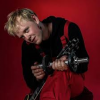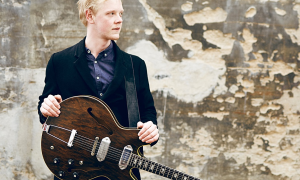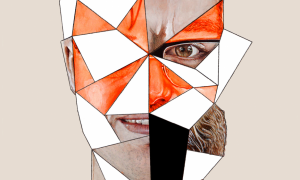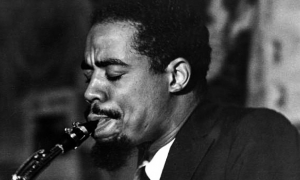Home » Jazz Articles » Hi-Res Jazz » New Music in an Anxious Time: Teis Semey, Peggy Lee and ...
New Music in an Anxious Time: Teis Semey, Peggy Lee and Philipp Gropper

Music can be a refuge, a way of escaping, if only briefly, the anxieties and harsh realities of life. It can also be a vehicle for resistance to oppressive social, political and economic conditions, a shared platform for channeling anger—and voicing hope—through the wordless medium of musical expression.
Billie Holiday's death in 1959, preceded by Lester Young (known by fellow musicians—if not by the wider jazz audience—to have been severely abused while serving in the Army), corresponds with the recording of Charles Mingus' masterpiece Mingus Ah Um. After Columbia Records executives declined to allow the lyrics of Mingus' attack on segregationist politicians, "Fables of Faubus," to appear in the recording, Mingus quit the label and recorded the original version for the independent Candid label, much as Billie Holiday had done, twenty years earlier.
Mingus, Max Roach, Abbey Lincoln, Nina Simone and Harry Belafonte, among many other artists, participated in marches and rallies, benefit concerts and church meetings, to advance the cause of civil rights. Responding to the continuing crises in African-American communities during the late '60s and early '70s, Archie Shepp recorded Attica Blues, Gary Bartz and Nju Troop released Harlem Bush Music, a favorite of members of the Black Panther Party, and Mingus wrote "Remember Rockefeller at Attica," and kept "Fables of Faubus" in his performing repertoire.
The situation for European jazz musicians in some respects paralleled that of their American counterparts. The 1968 uprisings occurred in the midst of an upwelling of free jazz and collective improvisation under the rubric of Emanzipation, a conscious break from what was perceived to be the strictures of American jazz forms and practices. Free improvisation music is noncommercial, anti-hierarchical, and insofar as it operates outside the institutional walls of conservatory-based contemporary jazz, anti-establishment.
Today, music that calls out the legacy of oppression, neglect of cities, systemic violence and racism, spans the world from the post-colonial global south to the post-industrial global north. In an era of irreconcilable political polarization, growing economic inequality, environmental degradation, and social instability, the three albums reviewed in this article, composed by jazz artists working in the Netherlands, Canada and Germany, display a range of creative musical responses to times of crisis.
 Teis Semey: Where the Fence Is the Highest (TRPTK)
Teis Semey: Where the Fence Is the Highest (TRPTK) Where the Fence Is the Highest, an ambitious work of new creative jazz, heralds the arrival of Teis Semey, a talented composer-guitarist. The Danish guitarist, a graduate of the Conservatorium van Amsterdam jazz performance program, has established a performing career in the Netherlands, earned praise from critics, and built a growing audience of enthusiastic fans. In his home country of Denmark as well as his current home in the Netherlands, there is deep resentment of immigrants and refugees, virtual walls between communities, and growing economic uncertainty, all of which are reflected in the title of the album, in texts threaded into the musical passages, and in Semey's own liner notes:
Everything is interconnected...as with the pending climate change disaster, the increasing global gap between rich and poor, and a growing sense of losing grasp on what it factual, it feels kind of doomy to live these days... a reminder to stay true and authentic in the art we make.
Where the Fence Is the Highest consists of two multi-part suites. "Japan Suite" opens with a wordless lament sung by singer Fuensanta Méndez Lecomte that sets the tone for the subsequent sections. Structured around the progress of the seasons, and inspired by the historical European encounter with Japan in the 19th century that was expressed as "Japonism" in the visual arts, the four sections evoke the changing moods of summer, fall, winter and spring, in subtle shadings of harmony and dynamics. In "Winter," pianist Xavi Torres builds a current of tension under vocalist Méndez's plaintive text recital. As Temey's guitar and Nicoló Ricci's tenor sax weave counter-lines against the piano, that musical tension—a kind of suspended motion—is dispelled when, in "Spring," the melody returns, just as the season of renewal returns the sun to an ice-bound landscape. The collective arising of the ensemble brings "Japan Suite" to a joyous conclusion.
In his guitar part writing, Semey integrates the instrument fully into the ensemble. As a soloist, he values tone production and coherence of melodic lines over flashy technical displays and virtuoso gestures. Soloing only briefly at the opening and closing of the "Japan Suite" opens more space for pianist Torres and saxophonist Ricci. Semey is an accomplished player, and his willingness to play inside, rather than over, the ensemble, affirms a musical maturity. There are echoes of guitar luminaries Jim Hall, John Abercrombie and Terje Rypdal in Semey's solos, and some similarity of intention to the Brad Shepik album Human Activity Suite on Songlines.
Semey traces his inspiration for the second suite, "Armed to the Teeth," to the writings of Friedrich Nietzsche, and to his own observations of a world riven by cultural, political and economic divides. After an evocative prologue, Semey features his own soloing skills in "Palm," a slow elegiac waltz for guitar/bass/drums trio, with the alto saxophone and trumpet periodically commenting from the sidelines. "Knuckles" showcases drummer Sun-Mi Hong, whose subtle touch conducts the ensemble and underscores Alistair Payne's dark-hued, speech-inflected trumpet lines and Mo van der Does' probing saxophone improvisation. Proceeding without a break into the third part of the suite, "Fingers," Semey's compositional drive propels the players into higher emotional expression—this is not academic, cerebral writing, but felt experience translated into sound. The work comes to a close in the epilogue, again a feature for the guitar. Fleet lines cleanly articulated, modest use of effects, and subtle shadings of dynamics keep the work in sharp focus through to the ending.
TRPTK is a new and growing label based in the Netherlands. Producer-engineer Brendon Heinst recorded Where the Fence is the Highest in DXD format at the legendary MCO Studio 2, the oldest radio studio in the Netherlands, where many great jazz musicians have recorded since the 1950s. Using an array of Sonodore and Neumann microphones, Heinst captures the sound of the instruments in high-resolution while presenting a classic-style mix of the band as an integrated whole.
Personnel:
(Japan Suite) Teis Semey, Guitar; Fuensanta Méndez, Vocals; Xavi Torres, Piano ; Nicolò Ricci, Tenor Saxophone; Jort Terwijn, Double Bass ; Guy Salamon, Drums
(Armed to the Teeth) Teis Semey, Guitar; Mo Van Der Does, Alto Saxophone; Alistair Payne, Trumpet; Jort Terwijn, Double Bass ; Sun-Mi Hong [Drums Reviewed at 192kHz/24-bit, available in hi-res download resolutions, both PCM and DSD, and on CD.
 Peggy Lee: Echo Painting (Songlines)
Peggy Lee: Echo Painting (Songlines) New creative music can be difficult to describe in words. I often find myself asking: what does this piece sound like? But that's a lazy approach to listening, because it leads to facile comparisons—a dead end for critical thinking. Still, the question arises and shouldn't be evaded.
Even those who study music and play an instrument, and who can appreciate the hard work that goes into a technically accomplished performance, might not have a grasp of theory, harmony and composition sufficient to accurately describe and characterize a piece of new creative music. A practice that I follow when I'm uncertain about my response to a new musical recording is to approach it with an open mind; read the liner notes, articles and interviews; listen to earlier recordings by the artist. Research often clarifies why the music does—or does not—make a connection. Purposeful listening can expand one's receptivity to the new and unfamiliar.
An investment in purposeful listening to Peggy Lee's album Echo Painting, a collection of new original compositions, reveals the composer's inventiveness, wit, lyricism, and emotional depth. Digging into the strata of her many appearances on albums of new creative music opened my ears to her unique character as a collaborator, composer and soloist.
Over the past two decades, Vancouver resident, classically-trained cellist Peggy Lee has participated in many new music projects, both as a collaborator and as a leader. During her tenure in the New Orchestra Workshop, she played in ensembles led by Butch Morris, Wadada Leo Smith, René Lussier, Barry Guy and George Lewis. I became aware of Lee's work through her appearances on albums from the Songlines label: Wayne Horvitz One Dance Alone, Dalava The Book of Transfigurations, and Francois Houle In the Vernacular: The Music of John Carter. Lee collaborated with percussionist Alex Cline on Continuation (Cryptogramophone), and on François Houle's Cryptology, (Between the Lines).
The Vancouver creative music scene provides Lee with a pool of versatile musicians from which to draw, including her husband, drummer-composer Dylan van der Schyff, and trumpet player Brad Turner, who make strong contributions to the album. The twelve original compositions on Echo Paintings, arranged by Lee for an ensemble of two saxophones, trumpet, trombone, guitar, pedal steel guitar, violin, cello, bass and drums, are painted with a wide palette of emotional colors, and the work's overall title could be interpreted as characterizing how musical events from the past make their presence felt in the present.
Lee cites Carla Bley's writing for the Liberation Music Orchestra as an inspiration for the album. That's a telling point of comparison. Recorded in April 1969 during an era of political ferment, the album Liberation Music Orchestra honored political liberation movements past and present. In email communications, Lee told me that while her compositions were not intended as political commentary, she did feel that her work was a creative response in a time of anxiety.
"Out on a Limb" sets up a forward-propelled ostinato on the bass, drums, guitar and plucked cello; the horn section enters, a sustained long-line ensemble counterpart that drifts in and under trumpeter Brad Turner's deft solo. "Painting Echoes" features violinist Meredith Bates playing in an idiom that defies classification. Bates wrings soulfulness without 'blue notes,' and improvises outside the confines of bebop clichés. Drawing the violin bow close to the bridge, she shades her notes with overtones and voice-like inflection.
The ease with which composer Lee spins colorful musical threads conveys the breadth of her experience in so many different kinds of ensembles and projects. Insistently repetitive rhythms and clanging percussion in the first part of "A Strange Visit" creates an audio travelogue of a chaotic cityscape; as the din abruptly transitions into a quiet solo guitar interlude, soprano and tenor saxophone voices reemerge, calling on the other players to return, but more calmly. "Snappy" pits the cello against an onslaught of noise from the ensemble.
Large-scaled ensemble performances are not economically viable without institutional support; Peggy Lee received support from the 2016 Vancouver International Jazz Festival for the concert performance, and a Canada Council for the Arts grant to record the music after its premiere.
Recorded in 96/24. Engineered by Sheldon Zaharko at The Warehouse Studio in Vancouver, mixed by Dylan van der Schyff and Chris Gestrin.
Personnel: Brad Turner, trumpet; Rod Murray, trombone; Jon Bentley, tenor and soprano saxophones; John Paton, tenor saxophone; Meredith Bates, violin; Peggy Lee, cello; Bradshaw Pack, pedal steel guitar; Cole Schmidt, electric guitar; James Meger, electric bass; Dylan van der Schyff, drums. Robin Holcomb, vocal on "The Unfaithful Servant."
 Philipp Gropper's Philm: Live at Bimhuis (Why Play Jazz)
Philipp Gropper's Philm: Live at Bimhuis (Why Play Jazz) Anger—righteous anger—is a powerful force that can animate a musical performance beyond its conceptual limitations.
From an interview with Philipp Gropper in Jazzkaar:
I could go into politics now, talking about all the neo-liberalist crimes, that destroy on so many levels... Well, of course you wish that the music you do is relevant, that it's valued in a way, it gives people something.
Philipp Gropper's Philm: Live at Bimhuis , on the independent German music label WhyPlayJazz, was released as a transition between Philm's 2017 studio album Sun Ship, most of which is performed live on the present album, and their forthcoming release Consequences. For musicians who work in noncommercial creative music, the oppression of neo-liberal economics takes the form of marginalization by the dominant music streaming services, and limited opportunities to reach listeners beyond the boundaries of the artist's home region. Philm's earlier recordings and live performances in Germany and neighboring countries have received outstanding reviews in the German jazz press and the multinational freejazzblog.org site, but less attention in English-language publications.
If it were not for the appearance of this hi-res release in the weekly additions at my preferred download vendor, I would certainly have missed it altogether. None of Gropper's previous albums have shown up in my local record store, nor have I ever heard his music played on the jazz radio station in my area.
These suites of partly composed, partly improvised music, with their dark motives, unsettling use of electronics and unexpected twists and turns of phrasing , suggest the sense of unease that people of Gropper's generation confront, as they watch the fabric of their societies torn by economic stress, diminishing expectations, and the malign influence of demagogic politicians. The players, all veterans of new creative music projects, work through a sequence of moods with technical skill and collective interaction. Philm adopts a different strategy to create an effect similar to that of Teis Semey's ensemble: where Semey writes compositions and arrangements that bring attention to each of the players, Gropper and his colleagues build a collective performance framework that foregrounds the group as a whole, without subsuming the individual contributions of each of the quartet members.
It would be a misrepresentation to isolate individual tracks from an album designed to be heard in a nearly continuous sequence. The segments flow one into the other, without a full break until the end of "Who Owns the World Part 2," the fifth track of the album and the conclusion of the second of two long suites.
With this pointed title, Gropper makes clear his skeptical response to the arrogance and greed that undermine neo-liberalist claims of universal economic advantage. In performance, those sentiments find a voice through the alternating wind up and release of tension among the players. In the opening of "Who Owns the World Part 1," Gropper and bassist Robert Landfermann hold down the repetitive establishing theme while pianist Elias Stemeseder and drummer Oliver Steidle add complex percussive embellishments; when Gropper progresses into his solo, the piano and drums shift down into simpler rhythmic patterns of locked accents. As the tenor saxophone soars into the upper register, the rising amplitude and energy of the ensemble threatens to break loose into cacophony. A suspended passage for the piano flows seamlessly into a synthesizer solo over calmer musical waters; Gropper's second solo responds to rhythmic cues from the piano, which in turn joins the saxophone in unison. The trio of piano, bass and drums convey a sense of calm —but also of loss—drawing the performance to its conclusion.
This live performance, presented in excellent recorded sound, channels the distress of modern-day urban life; the anxiety, tension and anger that that all too often find expression in destructive acts of resentment rather than creative acts of resistance. Philipp Gropper has found a way to engage musically with his own response to those social conditions, and in Philm, a group of fellow musicians who can convey the emotional depth of that response to the listening audience.
Personnel: Philipp Gropper, saxophone and composition; Elias Stemeseder, keyboard, piano; Robert Landfermann, double bass; Oliver Steidle, drums
Recorded in 96/24 on July 30, 2017 by Marc Schots at BIMHUIS, Amsterdam, Netherlands.
Tags
PREVIOUS / NEXT
Support All About Jazz
 All About Jazz has been a pillar of jazz since 1995, championing it as an art form and, more importantly, supporting the musicians who make it. Our enduring commitment has made "AAJ" one of the most culturally important websites of its kind, read by hundreds of thousands of fans, musicians and industry figures every month.
All About Jazz has been a pillar of jazz since 1995, championing it as an art form and, more importantly, supporting the musicians who make it. Our enduring commitment has made "AAJ" one of the most culturally important websites of its kind, read by hundreds of thousands of fans, musicians and industry figures every month.
























